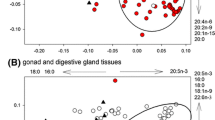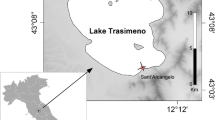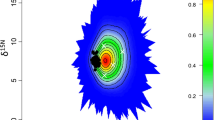Abstract
We utilised stable isotope ratios to assess differences in diet among three indigenous and syntopic rocky shore suspension-feeders (mussels Perna perna, barnacles Tetraclita serrata, and polychaetes Gunnarea gaimardi). We also determined the spatial and temporal variability in the suspension-feeder diets by collecting specimens on two occasions from two regions adjacent to hydrologically distinct river mouths (i.e. one with larger annual freshwater throughput than the other). The results showed that the isotopic niches (used as proxies for trophic niches) of the three species did not overlap and that the barnacles occupied a trophic position (3.4) well above those of the mussels (2) and polychaetes (2.6). We ascribed the interspecific differences primarily to the disparate feeding mechanisms used by the species. Large-scale regional (~50 km) differences in suspension-feeder diets were apparent, but not small-scale (up to a few km north and south of each estuary mouth). The regional differences in diet resulted from the increased availability of estuarine-origin suspended particulate matter (SPM) and zooplankton in the region adjacent to the river with relatively larger freshwater output, although overall incorporation of zooplankton versus mixed SPM into consumer diets was relatively consistent between regions and through time. Temporal shifts in suspension-feeder diets were apparent from stable carbon isotope ratios in the consumers. Our results showcase the measurable effects of regional-scale processes that can alter the food sources for dominant primary consumers in the rocky intertidal, thus potentially affecting entire food webs through bottom-up processes. The clear evidence for trophic niche partitioning offers valuable insights into how potentially strong competitors can coexist.





Similar content being viewed by others
References
Allan EL, Ambrose ST, Richoux NB, Froneman PW (2010) Determining spatial changes in the diet of nearshore suspension-feeders along the South African coastline: stable isotope and fatty acid signatures. Estuar Coast Shelf Sci 87:463–471
Araújo MS, Bolnick DI, Machado G, Giaretta AA, Reis SF (2007) Using δ13C stable isotopes to quantify individual-level diet variation. Oecologia 152:643–654
Baird D, Winter PED, Wendt G (1987) The flux of particulate material through a well-mixed estuary. Cont Shelf Res 7:1399–1403
Barnes H (1959) Stomach contents and microfeeding of some common cirripedes. Can J Zool 37:231–236
Bode A, Alvarez-Ossorio MT, Varela M (2006) Phytoplankton and macrophyte contributions to littoral food webs in the Galician upwelling estimated from stable isotopes. Mar Ecol Prog Ser 318:89–102
Bolnick DI, Svanbäck R, Fordyce JA, Yang LH, Davis JM, Hulsey CD, Forister ML (2003) The ecology of individuals: incidence and implications of individual specialization. Am Nat 161:1–28
Bustamante RH, Branch GM (1996) The dependence of intertidal consumers on kelp-derived organic matter on the west coast of South Africa. J Exp Mar Biol Ecol 196:1–28
Davies BR, Stuart V, de Villiers M (1989) The filtration activity of a serpulid polychaete population (Ficopomatus enigmaticus (Fauvel)) and its effects on water quality in a coastal marina. Estuar Coast Shelf Sci 29:613–620
Decottignies P, Beninger PG, Rinc Y, Robins RJ, Riera P (2007) Exploitation of natural food sources by two sympatric, invasive suspension-feeders: Crassostrea gigas and Crepidula fornicata. Mar Ecol Prog Ser 334:179–192
Dubois S, Jean-Louis B, Bertrand B, Lefebvre S (2007a) Isotope trophic-step fractionation of suspension-feeding species: implications for food partitioning in coastal systems. J Exp Mar Biol Ecol 351:121–128
Dubois S, Orvain F, Marin-Léal J, Ropert M, Lefebvre S (2007b) Small-scale spatial variability of food partitioning between cultivated oysters and associated suspension-feeding species, as revealed by stable isotopes. Mar Ecol Prog Ser 336:151–160
Espinosa EP, Allam B, Ford SE (2008) Particle selection in the ribbed mussel Geukensia demissa and the eastern oyster Crassostrea virginica: effect of microalgae growth stage. Estuar Coast Shelf Sci 79:1–6
Fukumori K, Oi M, Doi H, Takahashi D, Okuda N, Miller T, Kuwae M, Miyasaka H, Genkai-Kato M, Koizumi Y, Omori K, Takeoka H (2008) Bivalve tissue as a carbon and nitrogen isotope baseline indicator in coastal ecosystems. Estuar Coast Shelf Sci 79:45–50
Grange N, Whitfield AK, De Villiers CJ, Allanson BR (2000) The response of two South African east coast estuaries to altered river flow regimes. Aquatic Conserv Mar Freshw Ecosyst 10:155–177
Hill JM, McQuaid CD (2008) δ13C and δ15N biogeographic trends in rocky intertidal communities along the coast of South Africa: evidence of strong environmental signatures. Estuar Coast Shelf Sci 80:261–268
Hill JM, McQuaid CD, Kaehler S (2006) Biogeographic and nearshore-offshore trend in isotope ratios of intertidal mussels and their food sources around the coast of southern Africa. Mar Ecol Prog Ser 318:63–73
Hill JM, McQuaid CD, Kaehler S (2008) Temporal and spatial variability in stable isotope ratios of SPM link to local hydrography and longer term SPM averages suggest heavy dependence of mussels on nearshore production. Mar Biol 154:899–909
Hunt MJ, Alexander CG (1991) Feeding mechanisms in the barnacle Tetraclita squamosa (Bruguière). J Exp Mar Biol Ecol 154:1–28
Jackson AL, Inger R, Parnell AC, Bearhop S (2011) Comparing isotopic niche widths among and within communities: SIBER—Stable Isotope Bayesian Ellipses in R. J Anim Ecol 80:595–602
Jacob U, Mintenbeck K, Brey T, Knust R, Beyer K (2005) Stable isotope food web studies: a case for standardized sample treatment. Mar Ecol Prog Ser 287:251–253
Layman CA, Araujo MS, Boucek R, Hammerschlag-Peyer CM, Harrison E, Jud ZR, Matich P, Rosenblatt AE, Vaudo JJ, Yeager LA, Post DM, Bearhop S (2012) Applying stable isotopes to examine food-web structure: an overview of analytical tools. Biol Rev 87:545–562
Lefebvre S, Harma C, Blin J-L (2009a) Trophic typology of coastal ecosystems based on δ13C and δ15N ratios in an opportunistic suspension feeder. Mar Ecol Prog Ser 390:27–37
Lefebvre S, Marìn Leal JC, Dubois S, Orvain F, Blin J-L, Bataillé M-P, Ourry A, Galois R (2009b) Seasonal dynamics of trophic relationships among co-occurring suspension-feeders in two shellfish culture dominated ecosystems. Estuar Coast Shelf Sci 82:415–425
McCutchan JH, Lewis WM, Kendall C, McGrath CC (2003) Variation in trophic shift in stable isotope ratios of carbon, nitrogen and sulfur. Oikos 102:378–390
Noffke A, Hertweck G, Kröncke I, Wehrmann A (2009) Particle size selection and tube structure of the polychaete Owenia fusiformis. Estuar Coast Shelf Sci 81:160–168
Parnell AC, Inger A, Bearhop S, Jackson AL (2010) Source partitioning using stable isotopes: coping with too much variation. PLoS ONE 5(3):e9672
Richoux NB, Froneman PW (2007) Assessment of spatial variation in carbon utilization by benthic and pelagic invertebrates in a temperate South African estuary using stable isotope signatures. Estuar Coast Shelf Sci 71:545–558
Richoux NB, Vermeulen I, Froneman PW (2014) Fatty acid profiles reveal temporal and spatial differentiation in diets within and among sympatric rocky shore suspension-feeders. Mar Ecol Prog Ser. http://www.int-res.com/prepress/m10581.html
Riera P, Stal LJ, Nieuwenhuize J (2002) δ13C versus δ15N of co-occurring molluscs within a community dominated by Crassostrea gigas and Crepidula fornicata (Oosterschelde, The Netherlands). Mar Ecol Prog Ser 240:291–295
Riisgård HU, Larsen PS (2010) Particle capture mechanisms in suspension-feeding invertebrates. Mar Ecol Prog Ser 418:255–293
Rossi F, Herman PMJ, Middelburg JJ (2004) Interspecific and intraspecific variation of δ13C and δ15N in deposit- and suspension-feeding bivalves (Macoma balthica and Cerastoderma edule): evidence of ontogenetic changes in feeding mode of Macoma balthica. Limnol Oceanogr 49:408–414
Schaal G, Riera P, Leroux C (2009) Trophic significance of the kelp Laminaria digitata (Lamour.) for the associated food web: a between-sites comparison. Estuar Coast Shelf Sci 85:565–572
Schaal G, Riera P, Leroux C, Grall J (2010) A seasonal stable isotope survey of the food web associated to a peri-urban rocky shore. Mar Biol 157:283–294
Syväranta J, Lensu A, Marjomäki TJ, Oksanen S, Jones RI (2013) An empirical evaluation of the utility of convex hull and standard ellipse areas for assessing population niche widths from stable isotope data. PLoS ONE 8:e56094
Tallis H (2009) Kelp and rivers subsidize rocky intertidal communities in the Pacific Northwest (USA). Mar Ecol Prog Ser 389:85–96
Troost K, Veldhuizen R, Stamhuis EJ, Wolff WJ (2008) Can bivalve veligers escape feeding currents of adult bivalves? J Exp Mar Biol Ecol 358:185–196
Vander Zanden M, Rasmussen J (1999) Primary consumer δ13C and δ15N and the trophic position of aquatic consumers. Ecology 80:1395–1404
Vizzini S, Mazzola A (2003) Seasonal variations in the stable carbon and nitrogen isotope ratios (13C/12C and 15N/14N) of primary producers and consumers in a western Mediterranean coastal lagoon. Mar Biol 142:1009–1018
Vizzini S, Mazzola A (2006) Sources and transfer of organic matter in food webs of a Mediterranean coastal environment: evidence for spatial variability. Estuar Coast Shelf Sci 66:459–465
Vorwerk PD, Froneman PW (2009) The importance of estuarine-derived carbon for the nearshore marine environment: studies on two contrasting South African estuaries. Afr J Aquat Sci 34:137–146
Wing S, Jack L (2012) Resource specialisation among suspension-feeding invertebrates on rock walls in Fiordland, New Zealand, is driven by water column structure and feeding mode. Mar Ecol Prog Ser 452:109–118
Xu Q, Yang H (2007) Food sources of three bivalves living in two habitats of Jiaozhou Bay (Qingdao, China): indicated by lipid biomarkers and stable isotope analysis. J Shellfish Res 26:561–567
Zhukova NV (2000) Fatty acid components of two species of barnacles, Hesperibalanus hesperius and Balanus rostratus (Cirripedia), as indicators of food sources. Crustaceana 73:513–518
Acknowledgments
We thank S. Dyaloyi for assistance in the field. This research was funded by the National Research Foundation of South Africa and Rhodes University, with bursary funding to I.V. provided by the Andrew Mellon Foundation, the Deutscher Akademischer Austausch Dienst, and the Ernest and Ethel Eriksen Trust. Stable isotope processing was completed at the Stable Light Isotope Laboratory at the University of Cape Town (Archaeology Department).
Author information
Authors and Affiliations
Corresponding author
Additional information
Communicated by M. G. Chapman.
Electronic supplementary material
Below is the link to the electronic supplementary material.
Rights and permissions
About this article
Cite this article
Richoux, N.B., Vermeulen, I. & Froneman, P.W. Stable isotope ratios indicate differential omnivory among syntopic rocky shore suspension-feeders. Mar Biol 161, 971–984 (2014). https://doi.org/10.1007/s00227-013-2358-6
Received:
Accepted:
Published:
Issue Date:
DOI: https://doi.org/10.1007/s00227-013-2358-6




